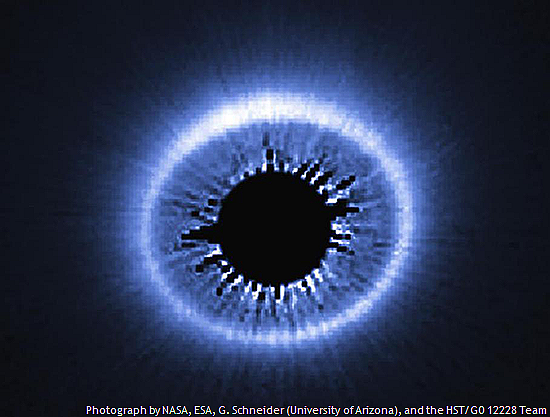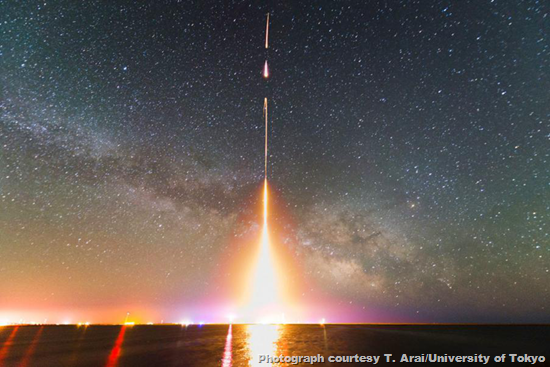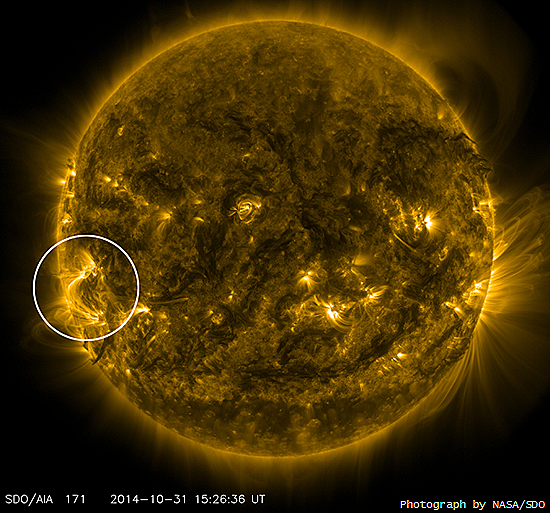
Week's Best Space Pictures: Rover Drills, Stars Collide, and a Rocket Launches
By Jane J. Lee, National Geographic News, 7 November 2014.
By Jane J. Lee, National Geographic News, 7 November 2014.
Curiosity drills Mars for rocky reassurance, some stars throw tantrums as they collide, and a rocket launches to study the sun.
1. Blue Eye
NASA's Hubble Space Telescope reveals the dusty aftermath of the violent birth of alien planets, seen in this view of the debris cloud surrounding a star.
Astronomers think these clouds form when asteroids, comets, and mini-worlds collide, leftover from eras of planet formation. To their surprise, this blue-eyed disc of dust is far from featureless, revealing regularly spaced spokes, ripples, and divots. The structure and complexity revealed by Hubble's observations hint at hidden forces shaping the disk. (See "Stunning Snapshot Shows Birth of Alien Solar System.")
Researchers speculate that hidden exoplanets orbiting the star might tug on the disk, sculpting its shape. Another possibility is that the debris field shifts as its star travels through interstellar space. (See "Three Theories of Planet Formation Busted, Expert Says.")
2. Star Light
A time-lapse image released November 6 shows the last of four rocket launches that carried aloft instruments aimed at measuring the brightness of space. Specifically, the instruments measured the amount of infrared light - or heat - between galaxies.
Turns out, there is a surprising amount of it - so much that the energy from the infrared light equals the light from all galaxies combined. Researchers suspect the infrared illumination originates with orphaned stars flung from galaxies. (See pictures of "Extreme Sun and Stars.")
3. Rocky Reassurance
In perhaps the most expensive drilling operation ever, NASA's Mars rover Curiosity drilled two holes into the base of the red planet's Mount Sharp.
The exercise confirmed orbital estimates of the mineral composition of the area, which included a lot more hematite than any previous rock or soil sample analyzed by the rover. (See "NASA's Mars Rover Makes Successful First Drill.")
The results offered reassurance that the rock outcrops the rover team intends to examine in the future should reveal whether habitable conditions once prevailed on Mars - which is why they named the flat patch of rock drilled by the rover "Confidence Hills."
4. Rapid-Fire Images
The Rapid Acquisition Imaging Spectrograph Experiment (RAISE), launched by NASA on November 6, will gather 1,500 images of the sun in five minutes.
Specifically, RAISE will gather images of an active area of the solar corona (circled) bubbling with complex magnetic fields, a vast witch's cauldron that threatens to unleash solar storms from the face of the sun.
5. Tantrums in Taurus
Located in a dark cloud within the Taurus constellation, several star systems are busily flinging jets of gas and debris into space.
XZ Tauri (left) is a multistar system ensconced in a rust-coloured cloud. Long thought to consist of only two stars - otherwise known as a binary system - one of the stars in the binary is now thought to be a pair of stars. That makes XZ Tauri a trinary system, made of three stars.
The bright blue cloud to the right contains another star, dubbed HL Tauri. The red streaks breaking away from the blue blob are jets of gas blasting out of newly formed stars. (Read on for more tales of Taurus's badly behaving stars.)
6. Citizen Cloud Project
NASA researchers have begun calling on citizens to help scientists confirm the cloud data taken by orbiting satellites.
This citizen science project involves kids and the public in taking pictures of clouds from the ground. Researchers can then compare the clouds to satellite pictures of them taken from above.
The effort will ensure that orbital instruments aren't missing vital information about clouds, a little-understood part of Earth's atmosphere. (Read an explainer of a rare rainbow cloud phenomenon that went viral.)
7. Wondrous Wreck
Instruments on the European Southern Observatory's Very Large Telescope captured the best image yet of a titanic clash: Galaxy ESO 137-001 ploughing into an enormous galaxy cluster (bottom, left).
The collision is ripping streamers of gas out of ESO 137-001. The bright blue streaks indicate gas moving towards Earth, and the red is gas is moving away from Earth.
The white, swirly material on the left side of the picture is a Hubble image of the galaxy cluster that has been superimposed on the ESO image.
Photo gallery by Sherry L. Brukbacher.







No comments:
Post a Comment
Please adhere to proper blog etiquette when posting your comments. This blog owner will exercise his absolution discretion in allowing or rejecting any comments that are deemed seditious, defamatory, libelous, racist, vulgar, insulting, and other remarks that exhibit similar characteristics. If you insist on using anonymous comments, please write your name or other IDs at the end of your message.